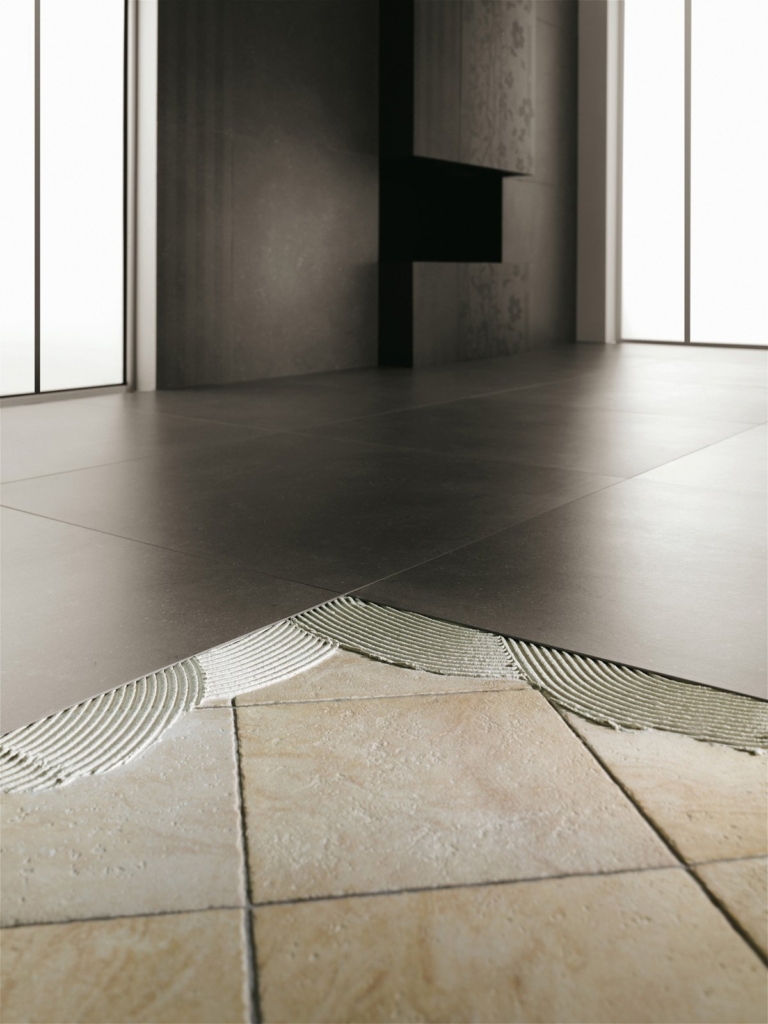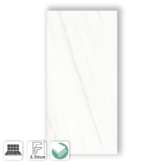
Thin porcelain tiles are an innovative and versatile solution for renovating the interior and exterior spaces of your home. These thin tiles, only a few millimeters thick, offer a number of advantages over traditional tiles in standard thicknesses. In the following guide, we will explore in detail the features, benefits and applications of thin porcelain overlay tiles.
What is thin porcelain stoneware?
Thin porcelain tile is a type of ceramic tile distinguished by its reduced thickness, usually between 3 and 6 mm. It represents an innovative and versatile solution for the renovation and furnishing of modern rooms. Its lightness, strength and aesthetics make it a popular material for both professionals in the field and individuals.

Characteristics of thin porcelain tiles for overlaying
Thin porcelain tiles are distinguished by the following characteristics:
- Reduced thickness: These slabs typically range in thickness from 3 to 6 millimeters, allowing for quick and easy installation without the need to demolish existing floors or walls.
- Lightness: Due to their reduced thickness, thin porcelain tiles are much lighter than traditional tiles in standard thicknesses, making them easier to handle and install.
- Strength and durability: Porcelain stoneware is a material that is extremely resistant to wear, scratches, impacts and stains, ensuring a long service life.
- Application versatility: These tiles can be installed on various types of surfaces, both horizontal and vertical, enabling a wide range of indoor and outdoor applications.
- Wide design choice: Thin porcelain tiles are available in a wide range of colors, textures and finishes, allowing you to customize the look of your rooms to suit your taste and design needs.
Advantages of thin porcelain tiles for overlaying
Thin porcelain tiles offer many advantages over traditional floor and wall tile solutions:
- Space saving: Due to their reduced thickness, thin tiles for overlapping allow you to gain valuable inches, which is particularly useful in rooms with limited space.
- Ease of installation: Installation of thin tiles is much easier and faster than that of standard tiles, as it does not require demolition work or preparation of the substrate.
- Less impact on renovation work: Installing thin tiles to be overlaid results in less disruption and shorter duration of work than removing and replacing existing floor or wall tiles.
- Renovation cost savings: Due to the ease of installation and the smaller amount of material needed, the use of thin porcelain tiles results in significant savings in renovation costs.
- Environmental sustainability: Porcelain stoneware is an environmentally friendly and recyclable material, helping to reduce the environmental impact of your renovation projects.

Applications of thin porcelain tiles for overlapping
Thin porcelain tiles can be used in a wide range of applications, both indoor and outdoor:
- Flooring: Because of their strength and durability, thin tiles are an ideal choice for renovating floors in homes, offices, stores and public spaces.
- Wall coverings: These thin slabs can be easily applied to walls, both indoors and outdoors, giving a modern and refined appearance.
- Countertops and tops: Thin porcelain tiles are an elegant and durable solution for making countertops in kitchens, bathrooms and other rooms.
- Furniture and home accessories: Due to their versatility, thin tiles can also be used to personalize and cover furniture and design objects.
- Terraces and balconies: Porcelain stoneware is particularly suitable for outdoor flooring, as it is resistant to weathering and temperature changes.
Installation of thin porcelain tiles to be overlaid
Installing thin porcelain tiles is a relatively quick and easy process due to their reduced thickness. Here are the main steps:
- Preparation of the substrate: Make sure the surface on which you intend to lay the tiles is clean, flat and free of irregularities.
- Adhesive selection: Select an adhesive specifically for thin tiles that provides excellent adhesion without deformation.
- Cutting and placement: Cut the tiles with special tools and arrange them on the surface, following a predetermined pattern.
- Grouting and sealing: Fill the joints between tiles with a compatible grout and seal the edges with a suitable sealant.
- Final cleaning: Remove any residual adhesive or grout from the tile surface to achieve a perfect result.
For proper and safe installation, it is recommended to rely on qualified professionals who can ensure the perfect installation of thin porcelain tiles.

Maintenance and cleaning of thin porcelain tiles to be overlaid
Maintenance and cleaning of thin porcelain tiles are extremely simple and require little care:
- Daily cleaning: Use a mild detergent and soft cloth to remove surface dirt.
- Extraordinary cleaning: To remove more stubborn stains, specific porcelain tile cleaning products can be used, carefully following the manufacturer’s instructions.
- Joint protection: Treat joints periodically with a protective sealant to preserve their integrity over time.
- Avoid harsh products: Avoid the use of acidic, abrasive or solvent cleaners, which could damage the tile surface.
Due to their low porosity and high chemical resistance, thin porcelain tiles require minimal maintenance, ensuring a flawless appearance over time.
Design and styles of thin porcelain tiles for overlaying
Thin porcelain tiles offer a wide range of design solutions, allowing you to customize rooms to suit your tastes and aesthetic needs:
- Glossy or matte finishes: You can choose from smooth, glossy surfaces or matte, more textured ones.
- Stone, wood or concrete effect: Thin tiles can faithfully reproduce the appearance of natural materials such as stone and natural wood, or concrete.
- Colors and decorations: A wide range of shades, from the most neutral to the most vibrant hues, as well as decorative patterns and custom graphics.
- Formats and sizes: Thin tiles are available in a variety of sizes, from classic rectangular shapes to more unusual and creative ones. In addition, thin tiles are also available in large sizes, up to more than 300 cm on a side.
Thanks to this extraordinary versatility of design, you can create unique and tailored solutions for your space, giving free rein to your creativity.
Conclusions
Thin porcelain overlay tiles are an innovative and cost-effective solution for renovating the interior and exterior spaces of your home. Due to their lightweight, durable and versatile application characteristics, these thin tiles offer numerous benefits over traditional standard thickness tiles. If you are interested in finding out more about thin porcelain tiles and their benefits, contact our experts. We will be happy to provide you with personalized advice and guide you in choosing the best solution for your needs.
-
Product on saleULTRA THIN TILES – NOIR DESIR LUC. 80X80
-
Product on sale3MM THIN TILES – FILO PECE 100X100
-
3MM THIN TILES – KERLITE SNOW BLACK & WHITE 100X100€ 26,50 + VAT
-
POLISHED WHITE MARBLE EFFECT PORCELAIN SLABS – GARDENIA ORCHIDEA MARMOTECA FROZEN LUX 120X280€ 30,00 + VAT
-
Product on saleULTRA THIN TILES – INVISIBLE WHITE I NATURALI 100X100
-
3MM THIN TILES – KERLITE WHITE A1 100×150€ 29,00 + VAT
-
Product on sale3MM THIN TILES – BLEND GRIGIO 50X100
-
ULTRA THIN TILES – FOKOS TALCO 80X162€ 140,00 + VAT
-
Product on sale3MM THIN TILES – BIANCO LASA I NATURALI 50×100










